Saturday, January 05, 2008
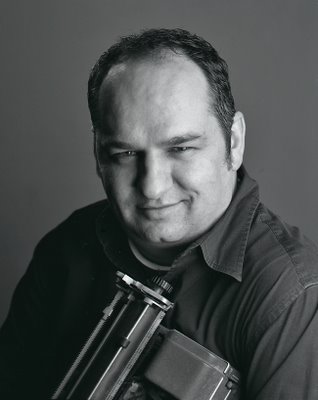 This blog will have Saturday January 5, 2008 as the date but it is wrong as this is being written the evening of January 6 when my website and blog was up again. The plug was pulled by Net Nation on Friday evening. Net Nation is the company I pay around $16.00 a year to keep my web page name from being used by my doppelgänger. On January 1, I was invited to a New Years day afternoon gathering at Tim Bray's and his wife. I meant to ask him something that had been on my mind for weeks. The question was in reference to what kept my web page and blog up and or prevented its extinction. A lot has been said that anything you write on the net is there forever. Was this true? Before the Christmas holidays Marni McLeod, one of the principals of Skunkworks had sent me a friendly letter informing me that while Skunkworks had designed both my web page and blog and hosted me for two years it was time to push me off the nest and I would have to renew my domain name. This I did (in early January, alas). But I never noticed that when I wrote British Columbia in the registration renewal form there was a little flag that said that only two initials were allowed (BC). I pressed send and that was the end of that. On Friday evening when my domain name had expired the folks at Net Nation pulled the plug. I never really had to ask Tim Bray in the end how wrong the idea is that anything one writes on the net is forever. What it means really is that just like in a photography one is nobody without a support staff such as Horst Wenzel one's website is utterly dependent on something as simple and "cheap" as the folks at Net Nation. But also something I cannot forget are the good folks of Skunkworks including lawyer/writer/designer Doug Jasinski (seen above with his typewriter) and Chris Botting, who without me knowing, gave me exactly what I wanted in this web page and blog. If I had only heeded Marni MCleod's advice to get on with it in December I would perhaps have asked Tim Bray the question, "How tenuous is my presence on the net?" and not believed a word he would have said.
Jack Williams - The Literary Tug Boat Cook
Friday, January 04, 2008
It was sometime in December, 1990, right after I photographed Jack Williams in a garage building a boat from scratch (he was the consumate craftsman) that I went to the Vancouver Magazine editor with the idea on a profile on Jack Williams. I was rebuffed with a terse, "He is a nobody. We are not interested." And that's how his negatives languished in my files until today as I read pages and pages of nobodies in today's Arts & Life section of my daily newspaper.
I felt a bit of rage reading (a glance, only a glance) about the latest trend in the top 10. This is, "Top 10 cool movies we're looking forward to in 2008". In defference to my literary friend and movie critic, I would give him a gun, before banishing every movie critic in town to a desert island. "And then there was one," John Lekich, I would hope.
For at least two decades my friends (including John Lekich) and I held a weekly (Thursdays) lunch at Vancouver's The Railwayman's Club (a.k.a. The Railway Club). Food was plain, almost inconsequential to compensate for the rich conversation. We conversed (now that chatting has that other dreadful meaning, converse will do wonderfully). Not being yet that famous (they), we conversed with William Gibson and Evelyn Lau. Buck Cherry was not quite John Armstrong and exotic dancers from the nearby Hotel St. Regis sometimes slummed at our table. My ritual was pouring a small glass of Tio Pepe into my soup. Most of us have scattered here and there and we sometimes meet at the club. The food is very much better but the conversation, dutifully nostalgic is not quite in the realm of conversation.
One man who would appear, every once in a while was Jack Williams. If there was some way of defining the man in a short sentence we would say, "He is the father of Vancouver starlet Barbara Williams." It was only around 1993 that we would have added, "and she is married to Tom Hayden."
But there was much more to Jack Williams. His face was a blend of Spencer Tracy, William Faulkner and Dashiell Hammett. His face was the kind of face you might see at the end of a steep climb on a mountain, you know, your cliché guru.
Williams fancied beer and tomato juice and on some days you might have suspected that he had breakfasted early with such a concoction. His voice was almost pure diction with only a hint of a slur. He would look at you with that permanent little smile of his eyes and would begin, "I read this thing in Harper's..."
Williams had been in logging camps and one of his many jobs was of cook on a tug boat and a logging barge. When he didn't cook he read or conversed with such friends as logging poet Peter Trower whom he called, "Pete."
My favourite Williams quality was his placidity. He made me relax. The world was just fine. And if it wasn't, it would soon be. Except for once.
We were visited one Thursday by sex crimes cop Steve Pranzl. Williams developed a instant liking for the handsome policeman. I could see the gleem in Williams's eyes and I could see what was coming. I didn't know what to do until Pranzl told us he had to make a call and got up. As soon as he was gone I whispered to Williams, "Don't offer him that special weed of yours, he's a cop."
Williams died sometime in the late 90s.
Thursday, January 03, 2008

History used to be taught in periods which stressed the salient civilizations of a particular time, in isolation from others that may have been around, in decline or in upward development. It is only recently that civilizations have been taught in relation to others.
In much the same way it is easy to fall into the trap of looking at Vancouver's own history in a didactic, "it started here and ended here" sort of way. We also look at history in a neat and mathematically comforting decimal system of centuries and decades. Occasionally there are some great personalities that thwart that system For example there is Graham Greene who spanned Edwardian times and yet flew at supersonic speeds on the Concorde. People such as Greene teach us to look at history in a not so neat but ever so much more interesting way. Such is the case of our very own Dal Richards who celebrates his 90th birthday with a big bash concert at the Orpheum on January 6.
Much like I have written here how one of our national flag designers, Patrick Reid can often be seen strolling in Kerrisdale, Dal Richards is a walking-history-lesson of what has happened (and is happening) in Vancouver while he has been around (and is around). This is specially true as Richards has a prodigious memory and an unwavering interest in the affairs of our city. Recently, while driving him (after having a chat in his apartment on Beatty Street) to a movie date with his wife Muriel, Richards pointed out buildings that had disappeared and noticed new ones and how they affected traffic. He told me he wanted to go on a long cruise and come back after the Canada Line was finished and the 2010 Olympics were over. "The traffic, downtown, might just be manageable then," he said.
Bob Mercer, the editor/art director of VLM (Vancouver Lifestyles Magazine) is keen on not only saluting our walking history lessons but also helping those who might not know about them to appreciate them through profiles in his magazine. A recent one featured my photograph and my short profile on Dal Richards. Here is the copy that accompanied the photograph above.
Dal's Place
Ral Richards, 89, is one very stylish Vancouver gentleman. His wife Muriel says, "Dal wears a tuxedo like a mechanic wears overalls. He looks comfortable in it. On cruise ships, others look like stuffed penguins." Richards says, "I dress the way a bandleader should dress."
Richards lost an eye when he was 8. His parents put him into the Kitsilano Boys Band as a recuperative therapy. He played a clarinet sold to them by George Leach, the bassoon player of the Vancouver Symphony. Leach also played in dance bands but had to sell the clarinet t support his family.
Richards, whose long-running Dal's Place airs on 600AM, Saturdays, 6 to 7 p.m., and Sundays, 9 to 10 p.m., has just released a new CD with his band. Of special note is Jim Byrnes singing " Blues in the Night," a tango version of " My Heart Belongs to Daddy" with young Vancouver singer Bria Skonberg and a killer version of " As Time Goes By" sung by Richards himself.
© 2007 VLM/Alex Waterhouse-Hayward
Nite Dreems With A Blonde & Brunette
Wednesday, January 02, 2008
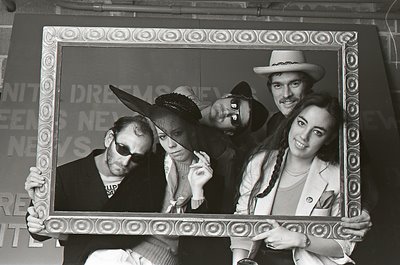 In 1972 photographer Robert Frank temporarily retired his Leica to produce, direct and film a documentary of the Rollings Stones on tour called Cocksucker Blues. Scenes of the Stones shooting up in a hotel room assured that this film has rarely been seen by anybody as the Stones imposed restrictions on when and where Cocksucker Blues could be viewed. Unless you have been able to buy or see a bootleg version your only chances are to go to Robert Frank retrospective (it was one at Presentation House quite a few years ago where I saw the film for my first time). One of the groupies in the film is a relatively unknown eyeglass wearing Annie Leibovitz. Cocksucker Blues pioneered everything that is considered normal now in MTV. MTV was a phenomenon when it began to broadcast in 1980 and by then few remembered Frank's contribution. Even fewer would remember Vancouver's. 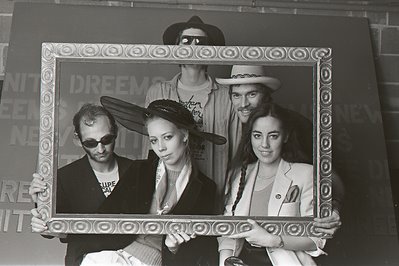 It all started with a couple of men, one short and one tall. The short one, J.B. Shayne had many monickers including the one important to our story, Raouel Casablanca. The tall one, "Long"John Tanner, managed to drive his wife's Mini in spite of his 6'4" frame. 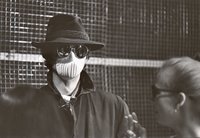 These two attached themselves to a decidedly uncool (he played jazz drums on the side) but supportive producer, Don Fraser (a.k.a. Mr. Tasty, wearing a white hat in the photographs here). The three hired two beauts, one a blonde, Deborah Jarvi and the other a brunette, Susanne Tabata. Their program, Nite Dreems went on the air on Cable 10 (at the time Cable 10 was at the foot of Cambie and Marine Drive).  Nite Dreems featured very early music videos including the Modernette's Barbra which to this day looks and sounds as fresh as it did in 1980. While Barbra was done with no budget (free I have been told) the folks at Nite Dreems managed with a very low one helped by Don Fraser's frugal habits. Connoisseurs of the active punk movement in Vancouver, of the incoming New Wave and other music that was off the charts and not on AM or FM watched Nite Dreems. They also might have enjoyed the skits and the humour. My reasons for watching it were more mundane. For me it was all about the blonde and the brunette. 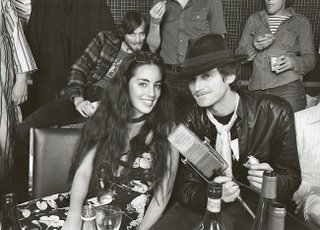
Today Is Tomorrow Because Your Today Was My Yesterday
Tuesday, January 01, 2008
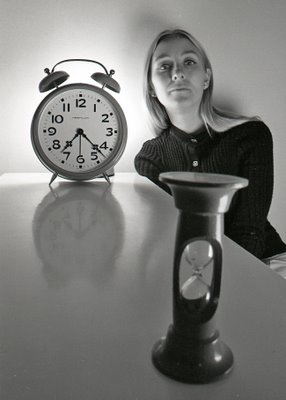 New Years is so much about time and clocks striking 12. This year Rosemary called me on her way home (last night) to tell me she was going to stop for grapes. Eating 12 grapes as the clock begins to strike midnight is supposed to be good luck in Spain and the custom has been in my family all these years. Safeway had no grapes and Rosemary did not think about trying a corner fruit store. Most Spaniards would say it is a lot easier to eat those 12 grapes in the form of brandy or Champagne. We did none of those things and retired for the night. Midnight found Rosemary asleep and me finishing Reginald Hill's Death Comes For The Fat Man. And, no, I will not reveal here if Detective Superintendent Andy Dalziel (pronounced Deel) indeed dies. I have written here about how Rebecca (when she stays for the night on Saturdays) is confused when I show her Sunday's (delivered at 9pm on Saturday night) New York Times. So I called her up last night at 9pm and told her that according to my New York Times it was Tuesday, January 1, 2008 at our home. It had to be the case, I insisted as it was clearly printed on the newspaper. I further confused her by telling her, "It's today here because tomorrow is today and your today was my yesterday." At that point my ever practical but still confused Rebecca said, "You should stop getting that silly paper."  The pictures here I took of Rosemary some 39 years ago in Mexico City. For anybody reading this I wish you a feliz y próspero año nuevo.
Oscar Peterson, Yapa, Post Christmas Angst & Lilly Dresses Up
Monday, December 31, 2007
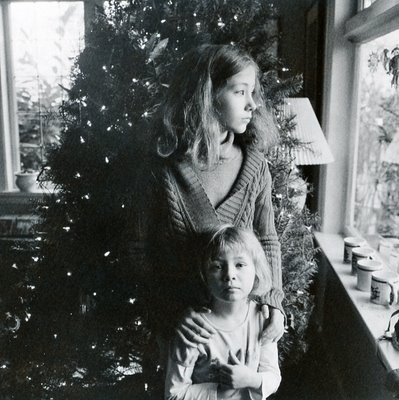 The Quechua (Peru/Bolivia/Northern Chile/Northern Argentina) word yapa (that y is pronounced like the J of Japan) is used in South America to mean something that you get extra particularly after you pay for it. Thus 20% more Kellogs Corn Pops would read 20% yapa in Argentina. We usually have Rebecca and Lauren on Saturdays but some last minute changes meant that they slept over Saturday night and we had them yesterday until the evening. For me it was a lot of fun even if it took me away from my holiday reading. Because they both slept in our bed I was relegated to what used to be Hilary's room. I had my tall pile of books so I did not mind. Both our cats, Toby and Plata also decided to sleep with me as it was much more quiet.  Of late Rebecca has been listening, over and over, to Very Tall- The Oscar Peterson Trio With Milt Jackson . She particularly likes Nat Adderly's Work Song . Driving over to her piano lessons almost a year ago, just as we crossed the bumpy intersection of 41st and Cambie, there was a loud crash. Rebecca wondered if a tire had blown. I told her it was the sound of cymbals from the Work Song. Since then she wants to listen to this particular song (with Milt Jackson playing vibes she has an added reason) recorded in 1962 when stereophonic meant just that in jazz records. 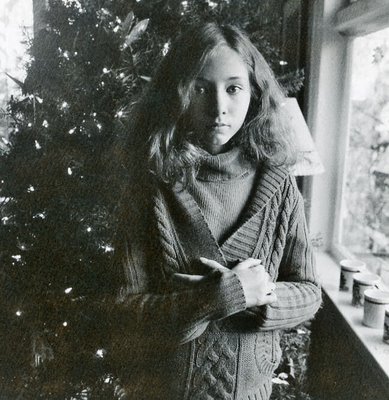 Rebecca was sad to find out that Peterson had died recently. We played lots of Peterson yesterday including a three casette (Book-of-the-Month Club recording) called Easy Does It. We also played some LPs called The Astaire Story featuring Oscar Peterson, Barney Kessel, Charlie Shavers, Flip Phillips, Ray Brown and Alvin Stoller. Fred Astaire sings and in some memorable cuts, tap dances as percussion to Peterson's piano. While Rebecca did not particularly notice this I know that it will lodge in her brain for future use. She did tell me, "I have a new Peterson favourite and that's Hymn to Freedom." She put on a light blue satin slip of Rosemary's and danced a slow ballet to it.  Late afternoon I asked both Rebecca and Lauren to pose by the Christmas tree for my Mamiya. I had loaded the Polaroid back with 3000 ISO b+w. I wanted to take pictures without my usual artificial lighting and I wanted to capture some post-Christmas angst. The idea was to portray the concept of a little girl who grows up and finally understands that Santa Claus.... Rebecca was very upset about this (and also as we did not have her usual special hair brush to fix up her hair) since she said that young girls might read this blog. I told her I didn't think that would happen. She quieted down and I was able to take my pictures. After the pictures she went to her favourite computer pastime of dressing up dolls and or young celebrities. I don't aprove and I tell her so. But Rosemary says it is perfectly normal for a 10-year-old to want to dress up dolls. She was doing this dressing up while holding Lilly. She had asked Rosemary's assistance to cut up some black satin to make a cape and mask so that Lilly could be a bandit. I took her portrait, this time without protest and I smiled as I thought of my wife Rosemary playing dress up dolls at her age. How wonderful! A full day of exquisite yapa.
The Solarized Polaroid - Rebecca Reversed
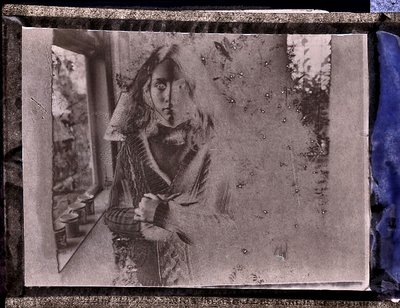 These days after Christmas are good days to plan for the next year and to experiment. Even if the tried and true techniques work just fine it is gratifying ot find new ways of doing things. In some cases these new ways hinge on working on old ways. I only once used Polaroid's extremely fast 667 which is a 3000 ISO b+w film. I used it to test my setup for a photo of Gillian Guess some years ago for Saturday Night. I had been instructed not to light the photograph so I used only the bare bulb over the bathroom sink. I had used Ilford's Delta 3200 film in the 120 format that matched the Polaroid's speed. 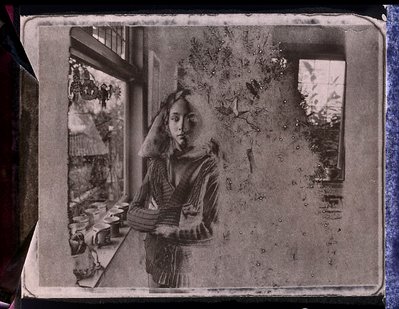 The peeled negative of the 667 Polaroid looks partially positive and negative. When I scanned these "negatives" of Rebecca by the Christmas tree and reversed the image in Photoshop the results looked a lot like partially solarized photographs.
Sunday, December 30, 2007
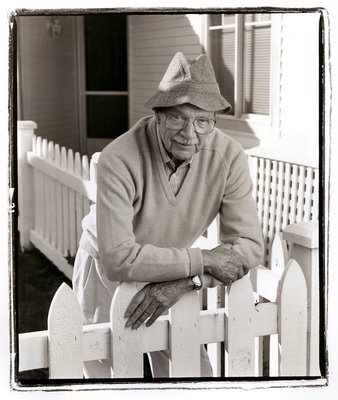
The other day I met retired Province arts writer Lee Bachus. I had never seen him before and I had no idea what he looked like. The shortish man with owl glasses and an almost permanent whimsical smile jarred me into thinking of all the talented writers who have worked for our local newspapers and how most have been forgotten. And once they have been forgotten I could assert that they never existed. And this is more so when there are few online archives where these writers can be found. In our modern 21st century era if you cannot be found on Google you do not exist.
When I first arrived in Canada I came from the tradition of appreciating very good editorial cartoonists in Mexico City newspapers. My favourite was Abel Quezada who worked for the daily Excelsior. Not too known is the fact that Quezada also managed to illustrate more than 11 New Yorker covers.
I had no idea what a salmon derby was nor did I understand how or why the Vancouver Sun sponsored this event. But I do remember seeing the wonderful cartoon illustrations by Len Norris on the subject in the 70s and early 80s and I was hooked by his humour. I was astounded to find out (driving one day by the lower road to the Horseshoe Bay ferry terminal) that Len Norris's Tiddlycove indeed did exist. It was thrilling to be assigned by Western (I am not sure if it was that magazine) to photograph Len Norris a few years before he died in 1997. By then he lived in a senior community in White Rock. I was not surprised that he had a white picket fence surrounding his property. I asked him to wear a hat much like the one he would draw on his unlucky fishermen.
Of the Vancouver Sun Salmon Derby there is not much information. Did it exist? Did it stop being an annual event when the salmon stocks were depleted? The important thing as we remember the events of this past year is to remember some of the others that helped shape the Vancouver we live in today. And one important contributor to our city was certainly Len Norris.
|























